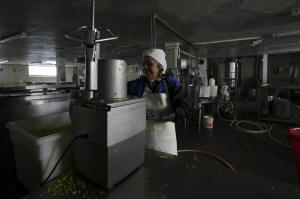Power shortages in Ecuador are melting away the future of a small town’s
ice-cream industry
 Send a link to a friend
Send a link to a friend
 [December 04, 2024] By
GONZALO SOLANO [December 04, 2024] By
GONZALO SOLANO
SALCEDO, Ecuador (AP) — Ice-cream production in Salcedo, a quaint town
in Ecuador's central highlands, began in the mid-20th century, born from
the ingenuity of Franciscan nuns.
Locals say the sisters would drink fruit shakes made with milk from the
region’s dairy farms until one of them began collecting the leftovers,
turning them into creamy popsicles that became an overnight sensation.
The nuns sold the popsicles in town to gather funds for the poor. But
the people of Salcedo saw a business opportunity and began experimenting
with new flavors and techniques, establishing a thriving popsicle
industry that has made their small town famous among ice-cream lovers.
However, a recent wave of power outages, triggered by a prolonged dry
spell, is threatening the future of Salcedo’s ice-cream industry and
melting away its dreams of a more prosperous future.
The daily power outages that began earlier this year and intensified in
September can last up to 14 hours. They have come about due to drier
than usual weather in Ecuador, which relies heavily on hydroelectric
plants. During most months of the year, hydroelectric plants produce
between 70% to 90% Ecuador’s electricity. The nation of 17 million
people invested heavily in dams over the past two decades, but it is now
struggling to come up with alternatives.

“We are living through the worst third-world conditions," said Gabriel
Pumasunta, owner of the Polar Bear ice-cream factory. “We're plunged
into darkness.”
Pumasunta, who runs the small company with his two brothers, said that
if the power outages continue this month, they will have no choice but
to shut down the plant.
“We will have to work elsewhere,” he said.
Pumasunta said that power outages have halted production and storage,
causing much of his product to melt.
Before outages intensified in September, Polar Bear was producing 60,000
popsicles per month, Salcedo said. Now, the small company makes 10,000
popsicles per month, and it has been forced to let go of eight of its 10
employees.
To stay afloat, Pumasunta has dipped into the company’s savings and
those of his family. He now works on the plant’s machines himself,
taking care of deliveries to bring down costs, while his parents have
also stepped up to help.
President Daniel Noboa, who was elected last year in a special election
that followed the resignation of Ecuador’s previous president, has not
been able to solve the electricity crisis. The chamber of commerce in
Guayaquil, Ecuador’s largest city, estimates that power outages are
generating weekly losses of $700 million for Ecuadorian businesses.
Germán Soria, president of the association of artisanal ice-cream
makers, said that before the power crisis, Salcedo had 80 small- and
medium-sized ice-cream plants and three large factories. Now, 30 of
these smaller plants have been forced to close.
Soria’s own ice-cream plant, housed in a shed behind his house, now sits
empty. He said he stopped production three weeks ago and has been forced
to sell some equipment, as well as a plot of land to cover his debts.
He said that the outages, which occur at unexpected times, make it hard
to plan production. “Our clients are also less keen to buy ice-cream,
because they’re not sure if they can keep the popsicles from melting."
[to top of second column] |

A worker wipes equipment at an artisanal popsicle factory in Salcedo,
Ecuador, Thursday, Nov. 28, 2024, amid a wave of power outages,
triggered by a prolonged dry spell. (AP Photo/Dolores Ochoa)
 According to local officials, the
power crisis has cost 300 jobs in Salcedo, a town renowned for its
fruit-flavored ice-cream, including flavors such as blackberries,
and taxo, an aromatic and somewhat acidic fruit that resembles
passion fruit.
President Noboa has promised that power shortages in Ecuador will
end this month, but analysts doubt his claim, saying the country
lacks the capacity to make up for a 1,900-megawatt deficit.
The Ecuadorian government has bought and rented dozens of large
electric generators that run on fossil fuels and are expected to
arrive in the following weeks. But as Marco Acuña, the president of
Ecuador's national guild of engineers, notes: "They do not have the
capacity to make up for the current deficit.”
Meanwhile in Salcedo, the collapse of the local ice-cream industry
has rippled through the local economy, impacting dairy farms, fruit
growers, transporters and mom-and-pop stores that specialized in
selling the famous popsicles.
“Before (the power cuts) we would buy up to 150 popsicles a day,”
said Maria Juliette López, who owns a small shop on the Panamerican
highway where tourists and truck drivers stop to buy snacks. “Now we
can only take up to 40 popsicles a day, because any product that is
left over will melt” when her freezer stops working, she said.
While the power outages appear to be hitting small- and medium-sized
producers and vendors the most, Salcedo’s three largest ice-cream
factories say they have also been impacted.
One of those is Corp Ice-Cream, whose factory used to buzz with
activity at noon, with its 35 employees working hard to produce up
to 20,000 popsicles per day. But during a recent visit to the plant,
there was only one employee sweeping in the dark, due to the lack of
power.
Paco Hinojosa, the company's manager, said Corp Ice Cream managed to
stay afloat thanks to its customers in the United States, which
order 120,000 popsicles per month during the summer. But the winter
months bring a halt to U.S. exports, which won't resume until around
March.
Corp Ice Cream’s sales in Ecuador have gone down by 40% since the
power outages began in mid September and that is taking a toll on
its suppliers. “We used to buy 2,500 liters of milk and 160 liters
of cream each day,” Hinojosa said. “Now we have cut down our orders
by half — and the same goes for fruit.”
Next to his desk, Hinojosa has a small altar to St. Michael the
Archangel, the city’s patron saint, whom he has been asking for
health — and more rain.
“It brings tears to your eyes to see this factory paralyzed due to
the lack of electricity,” he said.
All contents © copyright 2024 Associated Press. All rights reserved
 |